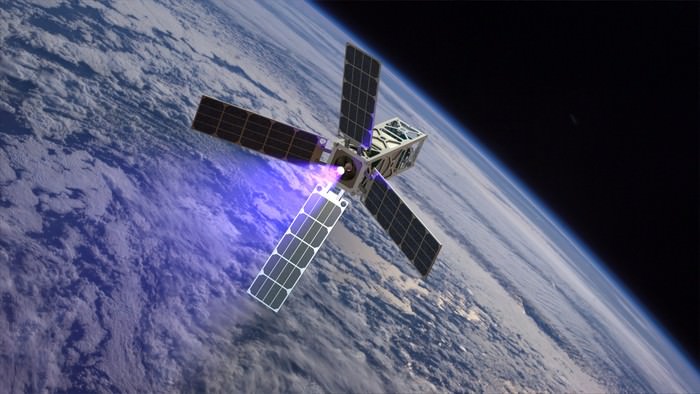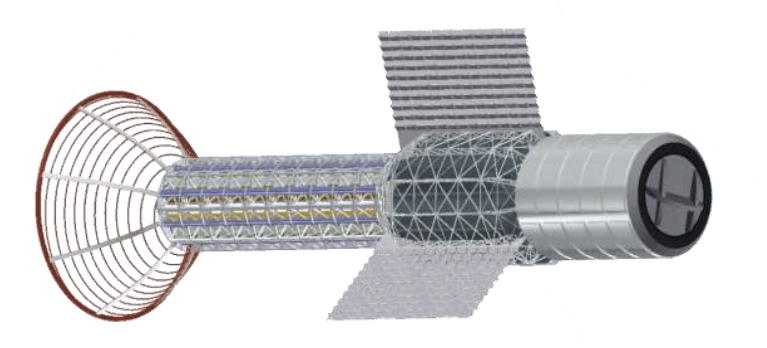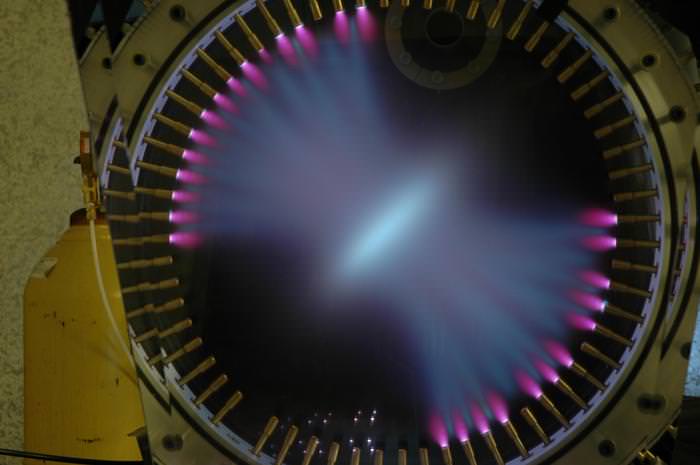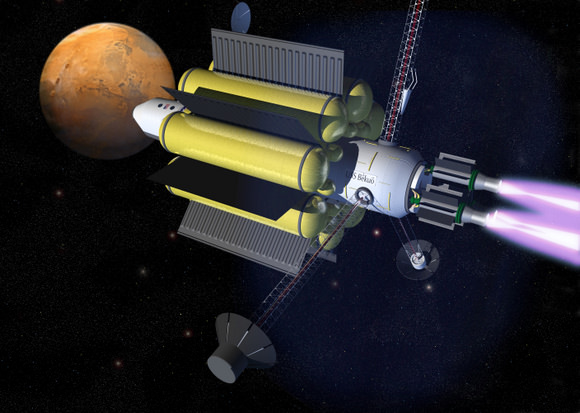We’ve reported on a technology called pulsed plasma rockets (PPRs) here at UT a few times. Several research groups have worked on variations of them. They are so popular partly because of their extremely high specific impulse and thrust levels, and they seemingly solve the trade-off between those two all-important variables in space exploration propulsion systems. Essentially, they are an extremely efficient propulsion methodology that, if scaled up, would allow payloads to reach other planets in weeks rather than months or years. However, some inherent dangers still need to be worked out, and overcoming some of those dangers was the purpose of a NASA Institute for Advanced Concepts (NIAC) project back in 2020.
Continue reading “Thermal Modeling of a Pulsed Plasma Rocket Shows It Should Be Possible To Create One”Plasma Thruster Could Dramatically Cut Down Flight Times to the Outer Solar System
I just finished the most recent season of The Expanse – my current favourite Sci-Fi series. Unlike most of my other go-to Sci-Fi, The Expanse’s narrative is (thus far) mainly contained to our own Solar System. In Star Trek, ships fly about the galaxy at Faster-Than-Light speeds giving mention to the many light years (or parsecs *cough* Star Wars) travelled to say nothing of sublight journeys within solar systems themselves. The distances between stars is huge. But, for current-day Earthling technology, our Solar System itself is still overwhelmingly enormous. It takes years to get anywhere.
In The Expanse, ships use a fictional sublight propulsion called The Epstein Drive to travel quickly through the Solar System at significant fractions of light speed. We’re not nearly there yet, but we are getting closer with the announcement of a new theoretical sublight propulsion. It won’t be an Epstein drive, but it may come to be known as the Ebrahimi Drive – an engine inspired by fusion reactors and the incredible power of solar Coronal Mass Ejections.

These Cubesats Could Use Plasma Thrusters to Leave Our Solar System

Cubesats are all the rage these days: they’re usually inexpensive and quick to build and they can tag along on launches already scheduled for other things. We think of cubesats as being almost “disposable” satellites – tiny spacecraft that go into Earth orbit for a short time, do their science and then burn up harmlessly in Earth’s atmosphere. But a team of scientists have a more long-term, long-distance plan for their cubesats. Benjamin Longmier and James Cutler from the University of Michigan want to build cubesats that have tiny plasma thruster engines that could propel them into deep space, maybe even interstellar space.
They have a vision of their plasma-thruster cubesat waving as it speeds past the Voyager spacecraft at the edge of our Solar System.
They are working on what they call the CubeSat Ambipolar Thruster (CAT), a new plasma propulsion system. This thruster technology doesn’t exist all in one piece yet, but Longmeir and Cutler said they could put it together in months, with just a little funding. The CAT plasma thruster will propel a 5kg satellite into deep space, far beyond Earth orbit, at 1/1000th the cost of previous missions.
They’ve begun a $200,000 Kickstarter campaign to help fund their project. Their ideas of what these thruster propelled cubesats could do are mind-bogglingly exciting: flying through the plumes of Enceladus to look for life, studying and tagging asteroids, formation flying through Earth’s magnetosphere to learn more about solar flares and the aurora or just an interplanetary message in a bottle lasting for hundreds of millions of years in orbit around the Sun.
They think they can get a satellite up and flying within 18 months.
“The traditional funding process starts with some seed data, a large government grant and a large number of milestones and gates to go through,” said Longmier in a press release from the University of Michigan. “We’d like to leverage Kickstarter funds to compress that timeline and go from initial seed data to flight in about 18 months, a much faster time scale than is possible with traditional grants.”
The cubesats would be about as big as a loaf of bread and the thrusters – the first of its kind — would use superheated plasma directed through a magnetic field to propel the CubeSat. The duo says that with this technology, exploring interplanetary space and eventually other planets would become faster and cheaper than ever before.
While plasma rockets have been used before, they’ve only been used on big spacecraft like Deep Space 1 and DAWN. Longmier and Cutler are miniaturizing the system. Most of the thruster components have been built and have been tested individually, but they need help through Kickstarter to assemble everything into one compact thruster unit for testing the integrated components in the lab, then in Earth orbit, and then interplanetary space.
They’ve got more info on how the thrusters work on their Kickstarter page.
I dare you to tell me this isn’t exciting!
More info from the University of Michigan.
Could Plasma Jet Thrusters Kickstart Interplanetary Travel?
A great offshoot from commercial space companies getting a foothold in real missions to orbit is that the old entrepreneurial space spirit seems to have been revived. People are attempting to develop and build what could be breakout space technologies, sometimes in their garages or basements. A new Kickstarter project is especially exciting, as it is looking to build a prototype electric pulsed plasma jet thruster, and the engineers behind the project say this could be used for reliable, high performance, low cost interplanetary space transportation.
UPDATE: HyperV has reached its Kickstarter goal and will be funded.
A group plasma physics researchers started a company about 8 years ago called HyperV, and they have come up with a new design for basic pulsed plasma jet technology. It runs on superheated ionized particles, and the engineers envision it could be used for orbital maneuvering, asteroid/comet rendezvous, orbital debris cleanup and interplanetary transportation.
They say that using this kind of electric propulsion would significantly reduce the mass and weight of spacecraft, resulting in more affordable missions. Although there are other types of electric propulsion systems that have been used for space travel – with mixed results — the HyperV team believes their new design offers solutions to problems in previous designs, and will ultimately provide cheaper and more robust space travel.
The team describes their project:
We believe our thruster technology has the potential to be just as efficient as existing electric thrusters (such as ion and Hall effect thrusters) and with similar specific impulse. But our advantages will be derived from a thruster that is less complex (and much more robust), which can use a variety of propellants including gases, inert plastics, and propellants derived from asteroids, Mars, the Moon, etc., It will also be far cheaper to build, and can be more readily scaled to larger sizes and very high power levels than current electric propulsion systems. Our plasma thruster technology should be scalable from a few kilowatts all the way up to megawatts of average power. The electricity which is needed to power electric thrusters would most likely come from new high performance solar panels, but could also utilize other compact energy sources. From a practical viewpoint for satellite design, our thruster will have much higher thrust per unit area than ion or Hall thrusters, thus taking up less room on the rear of the spacecraft.
They predict their prototype could produce a specific impulse (Isp) of 2000 sec, which is an equivalent to an exhaust velocity of 20,000 m/s.
They are looking to raise $69,000 by November 3, 2012 to get their project started. At the time of this writing, the team has just over $54,000.
Here’s a video from HyperV:
“We invite you, the citizens of Earth, to join with us as we design, construct, test, and execute this demonstration,” the team wrote on their Kickstarter page. “The culmination of this project will be an all-up, laboratory demonstration of our prototype thruster.”
Zubrin Claims VASIMR is a Hoax
[/caption]
A next-generation plasma rocket being developed by former NASA astronaut Franklin Chang Diaz called the Variable Specific Impulse Magnetoplasma Rocket (VASIMR) has been touted as a way to get astronauts to Mars in weeks rather than months, as well as an innovative, cheap way to re-boost the International Space Station. But in a biting commentary posted on Space News and the Mars Society website, “Mars Direct” advocate Robert Zubrin calls VASIMR a “hoax” saying the engine “is neither revolutionary nor particularly promising. Rather, it is just another addition to the family of electric thrusters, which convert electric power to jet thrust, but are markedly inferior to the ones we already have,” adding, “There is thus no basis whatsoever for believing in the feasibility of Chang Diaz’s fantasy power system.”
The VASIMR uses plasma as a propellant. A gas is ionized using radio waves entering into a plasma state. As ions the plasma can be directed and accelerated by a magnetic field to create specific thrust. The purported advantage of the VASIMR lies in its ability to change from high impulse to low impulse thrust as needed, making it an ideal candidate for a mission beyond low Earth orbit.
Chang Diaz’ company, the Ad Astra Rocket Company successfully tested the VASIMR VX-200 plasma engine in 2009. It ran at 201 kilowatts in a vacuum chamber, passing the 200-kilowatt mark for the first time. “It’s the most powerful plasma rocket in the world right now,” said Chang-Diaz at the time. Ad Astra has signed a Space Act agreement with NASA to test a 200-kilowatt VASIMR engine on the International Space Station, reportedly in 2013.
The tests would provide periodic boosts to the space station, which gradually drops in altitude due to atmospheric drag. ISS boosts are currently provided by spacecraft with conventional thrusters, which consume about 7.5 tons of propellant per year. By cutting this amount down to 0.3 tons, Chang-Diaz estimates that VASIMR could save NASA millions of dollars per year.
For the engine to enable trips to Mars in a reported 39 days, a 10- to 20-megawatt VASIMR engine ion engine would need to be coupled with nuclear power to dramatically shorten human transit times between planets.

Zubrin is the president of the Mars Society and author of the book “The Case for Mars: The Plan to Settle the Red Planet and Why We Must.” He has long touted the “Mars Direct” approach of getting humans to Mars to create a sustainable human settlement. The plan includes a series of unmanned and human flights to Mars using existing technology, as well as “living off the land” on Mars by creating rocket fuel to return to Earth, and using underground reservoirs of water on Mars.
In his commentary on VASIMR, Zubrin says, “existing ion thrusters routinely achieve 70 percent efficiency and have operated successfully both on the test stand and in space for thousands of hours. In contrast, after 30 years of research, the VASIMR has only obtained about 50 percent efficiency in test stand burns of a few seconds’ duration.”
On the ‘39 days to Mars’ claim, Zubrin says VASIMR would need to couple with a nuclear reactor system with a power of 200,000 kilowatts and a power-to-mass ratio of 1,000 watts per kilogram, while the largest space nuclear reactor ever built, the Soviet Topaz, had a power of 10 kilowatts and a power-to-mass ratio of 10 watts per kilogram.
Zubrin has invited Chang Diaz to a formal public debate the VASIMR at a Mars Society convention in Dallas next month.
Read Zubrin’s commentary on Space News or the Mars Society website.
More info: Ad Astra Rocket Company




